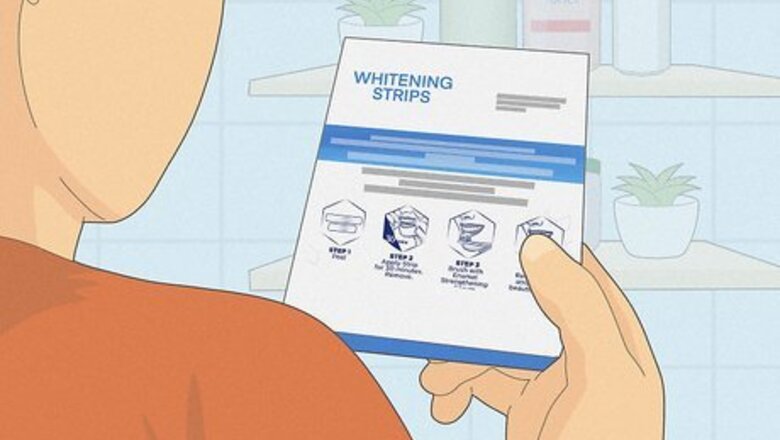
views
Whitening Strips Application
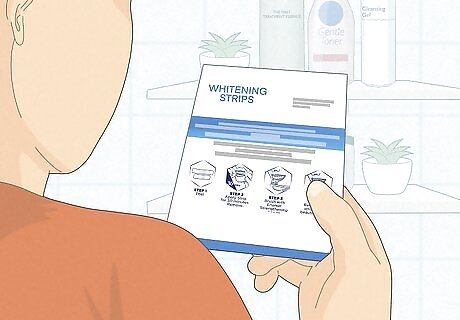
Read the instructions carefully. Although most whitening strips are applied and used in a similar manner, some brands may have different instructions. Always read the instructions fully and be aware of any side effects before using any whitening strip or whitening product. Misuse can cause damage to your teeth, gums, and health. Instructions can vary between brands, always fully read the instructions before use.

Brush your teeth. Before you apply your whitening strips, you need to brush your teeth. If you apply them without brushing your teeth, you may inadvertently trap food or bacteria under the strip and the surface of your teeth will not be in contact with the whitening substance, which can lead to an unappealing-looking result. Brushing your teeth can also help remove any plaque that may block the whitening effects of the strip on the enamel. Board-certified dentist Tu Anh Vu adds that "brushing your teeth will allow the hydrogen peroxide in the whitener to penetrate your enamel better." Brush your teeth at least a half-hour before you apply the strips to let saliva clean away any excess fluoride and get the enamel ready for whitening.

Prepare your strips. Before you apply the strips to your teeth, take a moment to make sure you are applying the right strip to the correct location. Some whitening strips have special strips for top and bottom teeth and all have a certain side of the strip that must touch the teeth. Take a moment to determine which strip goes where. Apply the side with gel to your teeth. This gel is the whitening agent and must contact the entire surface of your teeth—but not the gums—to work properly. The smooth side of the strip will have no whitening gel.
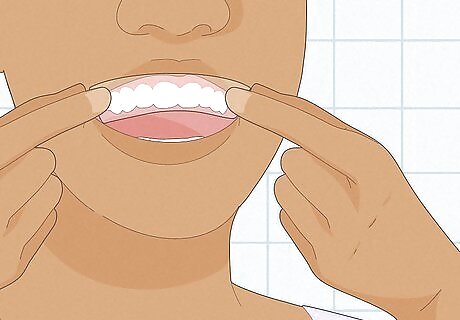
Apply the strips to your teeth. Place the strips over your teeth once you’ve determined which way they need to be applied. Have the side with the gel make contact with the surface of your teeth. Make sure the strip covers your teeth entirely for an even whitening, working out any bumps or uneven areas. Dry the surface of your teeth with a napkin or towel before applying the strips. This will help increase the whitening effect. You can also use a cheek retractor to spread your lips and control the flow of saliva during the whitening treatment. Less moisture in your mouth will give you a better result. Use a toothbrush to smooth out the strip if needed. Don’t let the strips reach up and cover your gums. The whitening gel can cause irritation or even slight burns that will bleach your gums.
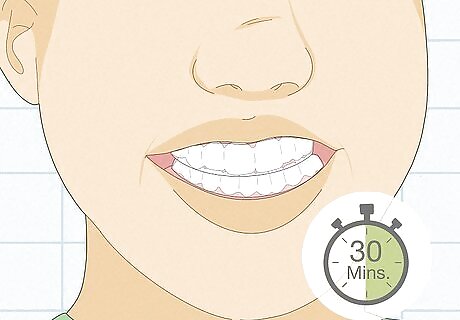
Wait for the strips to finish working. After applying the strips, wait the directed amount of time before removing them. Most brands will have slightly different amounts of time that they recommend, so carefully read your instructions. Avoid touching the strips to allow them to work uninterpreted. In general, the strips take about 30 minutes to work. In order to keep your teeth dry during the whitening procedure, lie on your back, keeping your mouth a little bit open. This will reduce the quantity of saliva, which may interfere in the whitening process. Try breathing through your mouth for a while as well to help dry out your mouth.

Take the strips off. After the amount of time that your specific product has instructed you to wear the strips has passed, remove the strips. Peel them away from your teeth and throw them out. For best results, board-certified dentist Tu Anh Vu advises to "not [eat] anything for an hour after your treatment." Don't leave them on longer than specified as this can cause irritation and sensitivity in the teeth and gums and won’t increase whitening results. Clean your mouth after using the strips. Rinse with water or brush your teeth to ensure that all the whitening gel is out of your mouth. Try not to swallow too much of the gel as it can be toxic.

Repeat the process. Whitening strips work over time, utilizing a slow exposure to the chemicals responsible for the whitening process. You need to repeatedly use the strips before seeing any noticeable difference in how white your teeth are. Keep using the strips for the recommended amount of time to get the most out of them. Board-certified dentist Tu Anh Vu suggests "using the strips monthly as a refresher once you get the shade you desire." Use twice daily for 30 minutes at a time. Sustained results can be expected at around four months, but they also work well after a professional teeth whitening in a dental office.
Cautionary Tips
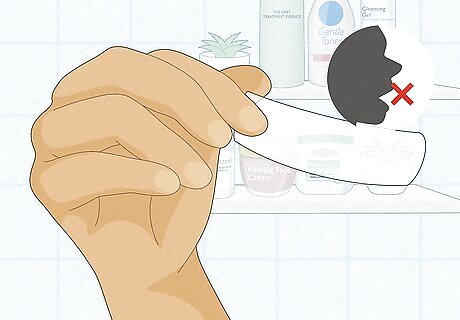
Don't swallow any gel from the strips. Some whitening strips contain hydrogen peroxide, which is poisonous if swallowed. Try to avoid swallowing any of the gel or saliva that is produced when wearing the whitening strips. Don't worry if you accidentally swallow a little bit of the gel. Small amounts will likely not produce any symptoms.
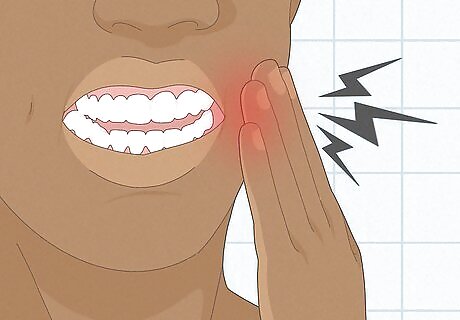
Stop if sensitivity occurs. The chemicals in whitening strips can cause some sensitivity in the teeth and gums. This may be the result of the gel coming into contact with the gums directly, applying the strips for too long or too often, or a sensitivity to the gel itself. Take a break from whitening strips if you notice your teeth or gums becoming sensitive.
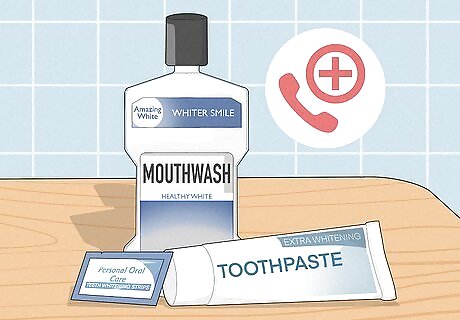
Ask your dentist before using any whitening product. Not all tooth whitening strips use the same chemicals and processes to achieve results. Some may actually exacerbate pre existing dental issues or cause new ones to arise. Ask your dentist if whitening strips and other whitening products are a good fit for you. EXPERT TIP Tu Anh Vu, DMD Tu Anh Vu, DMD Board Certified Dentist Dr. Tu Anh Vu is a Board Certified Dentist and Owner of Tu's Dental, her private practice, in Brooklyn, New York. With over six years of clinical experience, Dr. Vu helps adults and kids of all ages get over their anxiety with dental phobia. Dr. Vu has conducted research related to finding the cure for Kaposi Sarcoma cancer and has presented her research at the Hinman Meeting in Memphis. She received her undergraduate degree from Bryn Mawr College and a DMD from the University of Pennsylvania School of Dental Medicine. Tu Anh Vu, DMD Tu Anh Vu, DMD Board Certified Dentist Expert Warning: Do not use whitening strips if you have braces, dentures, or restorative work such as fillings, veneers, or crowns.
Regular Dental Care

Brush your teeth regularly. Regularly brushing your teeth is a great way to help keep them white and healthy. Make sure you are brushing your teeth properly and often enough to get the full benefit. Remember to take your time when brushing and reach every tooth completely. Brush twice daily, for around two minutes each time. Brushing too hard can remove enamel or damage the gums. Avoid using a toothbrush that is too hard (always use soft) and don’t use a new toothbrush immediately after the treatment or after drinking a soda, as the enamel is weakened and very sensitive to abrasion. You can use whitening toothpaste in addition to your whitening strips, but make sure to also use toothpaste with over 1100 ppm of fluoride, which may help with any sensitivity. Use strips and whitening toothpaste for two weeks to start, alternating the whitening toothpaste with the fluoride toothpaste (best used before bed).
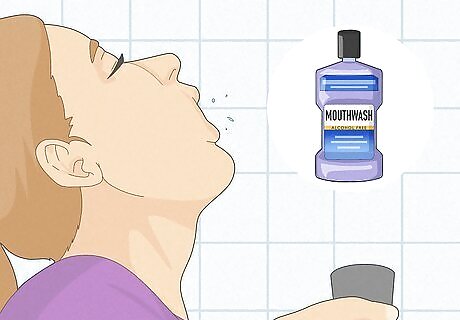
Use mouthwash. Using mouthwash in addition to regular brushing and flossing can help improve the health of your mouth and teeth. Mouthwash is used to kill bacteria as well as wash away any loose debris knocked loose by brushing or flossing. Swish your mouthwash for at least 30 seconds before spitting it out. If the mouthwash is too strong, dilute it with water using a 50:50 ratio. Consider using whitening mouthwashes in addition to your whitening strips.

Floss daily. Although flossing can be difficult and takes time, it’s an important step in maintaining the health of your teeth and gums. Flossing works by removing built up plaque and tartar that brushing might have missed. Keep in mind that it is better to prevent any future problems than spend loads of money to repair the damage. Start with a long piece of floss, about arm's length. Wrap the floss around your middle fingers, spanning the gap between your hands. Work the floss down in between teeth on both sides of each gum papilla (the gum triangle which is located between teeth). Pull the floss to one side of the tooth, forming a “c” shape. Move the floss up and down the length of the tooth to clean it.

Avoid certain foods. Some foods can cause your teeth to become stained, resulting in a yellowish coloration. Other foods can cause your enamel to wear down, which can lead to tooth damage and pain. Avoid the following foods and drinks as you work to whiten your teeth: Coffee, tea and wine can cause your teeth to become stained. Sugary foods or highly acidic drinks, like orange juice or soda, can wear the enamel away on your teeth. This can cause cavities or other dental issues.
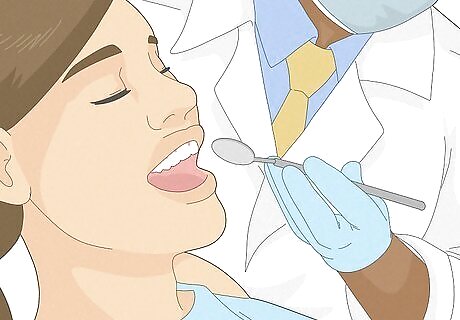
Visit with your dentist. Make regular appointments with your dentist to keep up with your dental health. Your dentist can help you to catch small dental issues before they become serious, as well as help you maintain regular care practices. Your dentist may be able to provide whitening services for you and help you to track their progress.











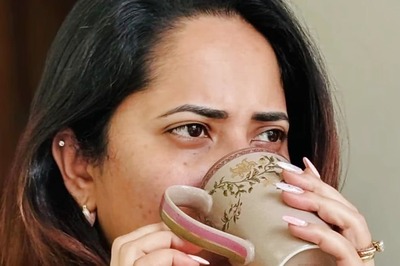

Comments
0 comment